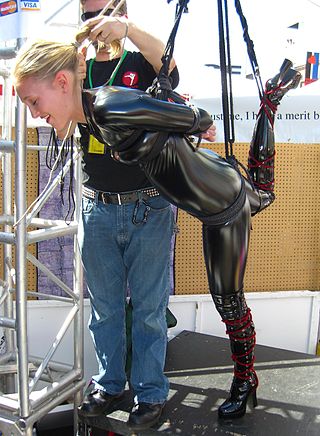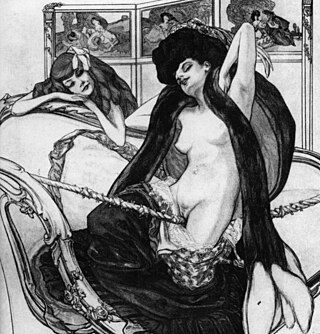
Bondage, in the BDSM subculture, is the practice of consensually tying, binding, or restraining a partner for erotic, aesthetic, or somatosensory stimulation. A partner may be physically restrained in a variety of ways, including the use of rope, cuffs, bondage tape, or self-adhering bandage.

Handcuffs are restraint devices designed to secure an individual's wrists in proximity to each other. They comprise two parts, linked together by a chain, a hinge, or rigid bar. Each cuff has a rotating arm which engages with a ratchet that prevents it from being opened once closed around a person's wrist. Without the key, the handcuffs cannot be removed without specialist knowledge, and the handcuffed person cannot move their wrists more than a few centimetres or inches apart, making many tasks difficult or impossible.

A glove is a garment covering the hand, with separate sheaths or openings for each finger and the thumb. Gloves extending past the wrist are called gauntlets. Gloves protect and comfort hands against cold or heat, damage by friction, abrasion or chemicals, and disease; or in turn to provide a guard for what a bare hand should not touch.

Bondage cuffs are restraints designed for use in sexual bondage situations. Compared to conventional handcuffs, they are wide wrist and ankle restraints generally made of leather, often padded with soft leather or fake fur. Bondage cuffs may be fastened at the wrists and/or ankles by a locking mechanism, by a buckle or by velcro. They are secured around the wrist or ankle, and the cuffs may then be attached to each other or another object.

A shirt is a cloth garment for the upper body.

Bondage in BDSM, is the activity of tying or restraining people using equipment such as chains, cuffs, or collars for mutual erotic pleasure. According to the Kinsey Institute, 12% of females and 22% of males respond erotically to BDSM.

BDSM is a variety of erotic practices involving dominance and submission, roleplaying, restraint, and other interpersonal dynamics. Given the wide range of practices, some of which may be engaged in by people who do not consider themselves as practicing BDSM, inclusion in the BDSM community or subculture is usually dependent on self-identification and shared experience. Interest in BDSM can range from one-time experimentation to a lifestyle.

The spreadeagle is the position in which a person has their arms outstretched and legs apart, figuratively resembling an eagle with wings spread. It is a style that appears commonly in nature and geometry. In human style it is represented by the letter "X".

Cock and ball torture (CBT) is a sexual activity involving the application of pain or constriction to the penis or testicles. This may involve directly painful activities, such as genital piercing, wax play, genital spanking, squeezing, ball-busting, genital flogging, urethral play, tickle torture, erotic electrostimulation, kneeing or kicking. The recipient of such activities may receive direct physical pleasure via masochism, or emotional pleasure through erotic humiliation, or knowledge that the play is pleasing to a sadistic dominant. Many of these practices carry significant health risks.

Suspension bondage is a form of sexual bondage where a bound person is hung from one or more overhead suspension points. It carries a higher risk than other forms of sexual bondage.

A gag is a device used in sexual bondage and BDSM roleplay. Gags are usually associated with roleplays involving bondage, but that is not necessarily the case. The person who wears the gag is regarded as the submissive partner, while the other is regarded as the dominant one. People may wear gags for a variety of reasons. Some people derive erotic pleasure from a gag, either in a submissive or dominant role. When combined with other physical restraints, the wearing of a gag can increase the wearer's sense of helplessness and anxiety level within a BDSM scene by rendering them unable to speak during sexual activity, which some people enjoy.
Sleepsacks are a type of bondage (BDSM) gear. Sleepsacks are primarily used to confine a person comfortably for an extended period of time. Similar to a conventional sleeping bag, a person climbs into a sleepsack and is usually zipped into it up to their neck. Generally sleepsacks are very tight on the body, much like mummification, which adds to the total encasement aspect of the experience.

A bondage suit, also commonly called a gimp suit, is a garment designed to cover the body completely, fitting it closely, and often including anchor points for bondage. It often has an attached hood; if it does not, it often is worn with a bondage hood or "gimp mask". The suit may be made from any material--leather, PVC, rubber, spandex, and darlexx are the most usual. Leather, not being stretchy, cannot fit as tightly as the others.

A bondage harness is a piece of BDSM equipment worn for the purposes of bondage. The harness typically consists of a series of leather straps, usually between 1 and 2 cm wide, attached together in such a way as to allow a person to "wear" the item. Customization of the harness may be needed depending on the specific individual's body.

Fashion in the years 1750–1775 in European countries and the colonial Americas was characterised by greater abundance, elaboration and intricacy in clothing designs, loved by the Rococo artistic trends of the period. The French and English styles of fashion were very different from one another. French style was defined by elaborate court dress, colourful and rich in decoration, worn by such iconic fashion figures as Marie Antoinette.

Court uniform and dress were required to be worn by those in attendance at the royal court in the 19th and early 20th centuries.
The Medieval period in England is usually classified as the time between the fall of the Roman Empire to the beginning of the Renaissance, roughly the years AD 410–1485. For various peoples living in England, the Anglo-Saxons, Anglo-Danes, Normans and Britons, clothing in the medieval era differed widely for men and women as well as for different classes in the social hierarchy. The general styles of Early medieval European dress were shared in England. In the later part of the period, men's clothing changed much more rapidly than women's styles. Clothes were very expensive and both the men and women of lower social classes continued also divided social classes by regulating the colors and styles these various ranks were permitted to wear. In the early Middle Ages, clothing was typically simple and, particularly in the case of lower-class peoples, served only basic utilitarian functions such as modesty and protection from the elements. As time went on the advent of more advanced textile techniques and increased international relations, clothing gradually got more and more intricate and elegant, even with those under the wealthy classes, up into the renaissance.

A human pony harness is used for bondage - which can be for restraint, decoration and/or to facilitate work such as pulling a cart. It is usually made of leather but can be rope, biothane or other appropriate material. It is wrapped around the wearer's body in such a way that it cannot be slipped off. The wearer may have his/her hands strapped behind his/her back, although this is not usually recommended for pulling a cart or other work, in case of a fall. D-rings can be attached, so ropes or chains can be put on to lead the person around.

Pussy torture is a BDSM or sexual activity involving the application of pain or pressure to a vulva or vagina, typically in the context of sadomasochism. It is sometimes considered to be an analogue of cock and ball torture. Pussy torture is meant to be done consensually in the case of BDSM. The recipient may take part in order to provide pleasure to a sadistic dominant. Another motivation is to receive masochistic pleasure from the activity. Mild examples of pussy torture sometimes occur in conventional sex, while the more extreme ones are usually kink practices.


















